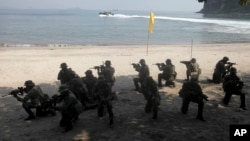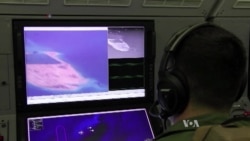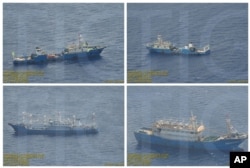Secretary of Defense Ash Carter said the United States-Philippines military relationship is “ironclad,” despite the Philippine president recently stating that U.S. special forces at Filipino bases should leave.
Carter was speaking aboard the USS Carl Vinson at port in San Diego, California, before meeting defense ministers from the Philippines and nine other members of the Association of Southeast Asian Nations (ASEAN) in Hawaii.
Thursday marked the first meeting between Carter and Filipino Defense Minister Delfin Lorenzana since President Rodrigo Duterte said his country would pursue an “independent foreign policy,” adding that “as long as we stay with America, we will never have peace.”
“But that was immediately walked back by the defense minister,” Gregory Poling, Director of the Asia Maritime Transparency Initiative at the Center for Strategic and International Studies, told VOA.
“Clearly the military brass in the Philippines does not feel the same way as (President) Duterte,” he added.
WATCH: South China Sea, N. Korea, Islamic State on ASEAN agenda
To date, U.S. officials tell VOA there has been no movement toward actually pulling American forces out of the southern Philippines.
A senior defense official said the U.S.-Philippines relationship has survived its “ups and downs” for more than 60 years.
“We’ll be engaging President Duterte further,” the defense official said. “I expect we’ll get through this.”
The U.S. and Filipino governments have a joint exercise planned in early October, but defense officials say they are uncertain about additional joint exercises beyond that one.
Secretary Carter will use the meeting to try to figure out how the Filipino military wants to move forward on the subject.
“We’ve heard different messages from the Philippines. We’re going to seek to clarify what their position is, and we’ll take it from there,” a defense official said.
The American and Filipino militaries have conducted three joint patrols in the South China Sea this year: one in March, one in April and one in July.
The U.S. also simultaneously deployed two aircraft carriers to the region during the first half of this year to demonstrate the U.S. commitment to maintaining peace and security there.
South China Sea
Carter called the Asia-Pacific region “the most consequential region for America’s future,” stressing that the U.S. must continue to work with its allies to improve maritime security in the East and South China Seas.
Gregory Poling of the Center for Strategic and International Studies said the South China Sea is going to be one of the most persistent security dilemmas that the region faces.
“There are no good answers,” he added.
China has claimed the vast majority of the South China Sea, which includes an international waterway that is used for an estimated $5 trillion in trade each year. Several other countries, include Vietnam and the Philippines, have overlapping claims.
An international tribunal ruled in July that China cannot legally claim ownership of 90 percent of the sea, but China has said it does not recognize the ruling.
A senior defense official said the U.S. considered the tribunal ruling “a great victory for international law and a rules-based order in the region.” Earlier this month, President Barack Obama called the decision “binding.”
Carter criticized Beijing for wanting to “pick and choose which principles it wants to benefit from and which it prefers to try to undercut.”
“For example, the universal right to freedom of navigation that allows China’s ships and aircraft to transit safely and peacefully is the same right that Beijing criticizes other countries for exercising in the region,” he said.
Carter said the “inclusive” Asian-Pacific security network allows any nation to contribute its capabilities and experiences to fighting coercion, terrorism and other transnational threats.
“No one is excluded, and by the way, that includes China and its military,” Carter said. “And we hope China doesn’t exclude itself.”
Islamic State
Defense against Islamic State attacks has also become “increasingly important” to the region and will be a big part of the ASEAN meetings in Hawaii, according to Poling.
U.S. defense officials estimate that the number of radicalized South Asians who have returned to the region is in the “low hundreds.”
“Local governments certainly are very concerned are about the possibility of a rise in ISIL-related violence,” a senior defense official said, using an acronym for Islamic State.
The number of Southeast Asians in Syria and Iraq probably doesn’t exceed 1,000, but those fighters are expected to return to the Asia-Pacific region over time.
Defense officials say the U.S. will be looking for opportunities to conduct counterterrorism training with Indonesians, Malaysians, the Philippines and Singapore in the future.
The U.S. will also seek ways to help Malaysia with counter-messaging against IS. Malaysia established a new regional counter-messaging center that became operational earlier this year.











